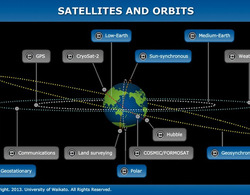A geostationary orbit is a type of geosynchronous orbit. It matches the Earth’s rotation but stays directly above the Earth’s equator.
Advantages: communication antenna can be permanently positioned rather than having to track the satellite, weather satellites in this orbit provide a constant view of the same surface area
Altitude: 35 786 km
Satellite period: 23 hours 56 minutes 4 seconds
Satellite examples: MTSAT-2 and other weather satellites, Optus D1 and other communications satellites
Transcript
Dr Allan McInnes
What we’ll often do is set up a special kind of geosynchronous orbit that we call a geostationary orbit – stationary part is the key word there because that tells you it means just sitting in one spot – and a geostationary orbit is one that has an inclination relative to the equator of zero. In other words. it’s just going around and around the equator. So a geostationary satellite will appear to hang at one spot in the sky, and those are extremely useful for communications satellites because you can just point an antenna at one place in the sky and it’ll always be pointed at the satellite. So we use that for things like satellite television, for communications, for some weather satellites as well. Although with weather satellites often we prefer geosynchronous orbits since we get a little bit of movement. So we’re always looking at the same part of the Earth but we get to see different angles of that Earth as we’re moving up and down.
How high up is the geostationary satellite? It will be at roughly 36,000 kilometres above the surface of the Earth.


